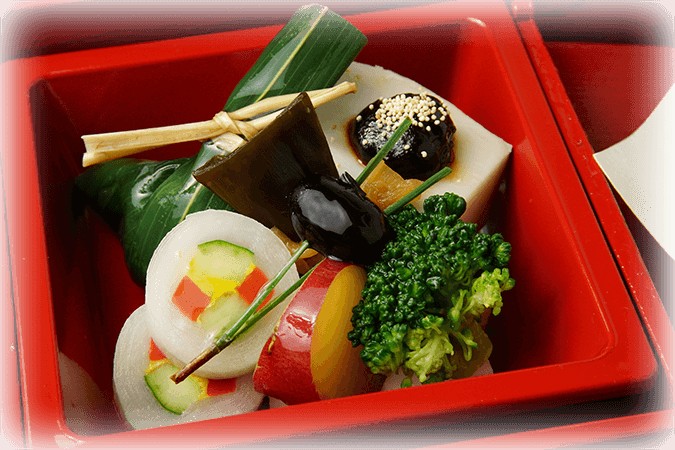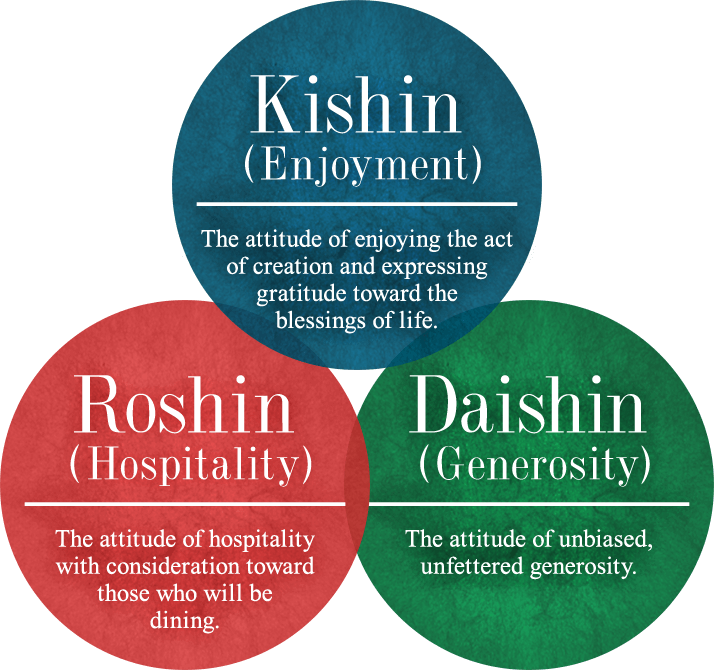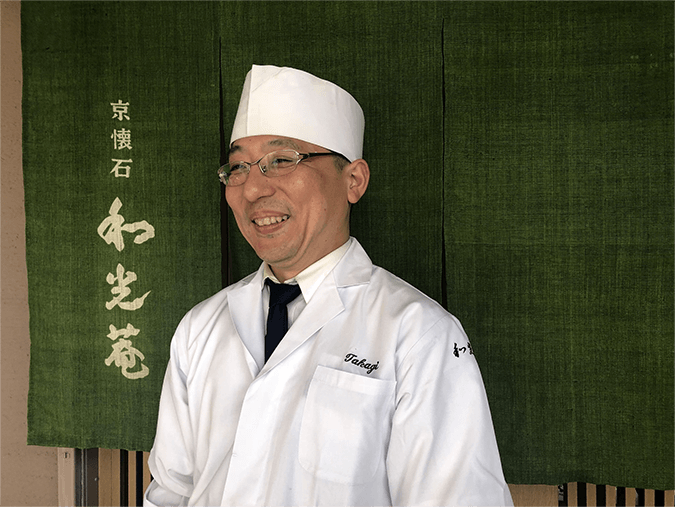Shojin-ryori /Buddhist Cuisine (Dinner)
We preserve tradition. But we also enjoy the new.
Please try WAQOO Shitaderamachi’s unique style of Shojin-ryori (Buddhist cuisine)
that we prepare with this approach.

Example Menu
[Appetizer] Wrapped and shaped mugwort wheat gluten, honey-simmered sweet potatoes, pine-needle skewered black bean, etc.
[Braised dish] Small decoratively-cut taro, Ganmodoki (deep-fried tofu containing bits of vegetables, etc).
[Decorative dish] White konnyaku, mozuku laver in grated yam, etc.
[Vinegared dish] Seasonal vegetables with bonito vinegar gelée, etc.
[Side dish] Sesame tofu, okra, etc.
[Dresses dishes – 4 types] Celery and shimeji mushrooms mixed with plum pulp, etc.
[Soup] Fried buckwheat dumplings in clear soup, etc.
[Rice dish] Green soybean rice, pickles, etc.
*The menu varies depending on season and availability.
*The picture is the menu of another day different from the example menu.
Explanation from
our Head Chef
The Formula behind Shojin Ryori consists of
3 “five” (five flavors, five preparation methods and five colors) plus 3 “attitudes.”
WAQOO Shitaderamachi’s Commitments in Dinner Preparation
Shojin ryori has long been prepared and consumed by priests.
It contains deep traditions that have been preserved unbroken.
One of these is the principle of five colors, five preparation methods,
five flavors and three attitudes.
We utilize this quintessential spirit at WAQOO Shitaderamachi as well.
Shojin-ryori's 3 sets of "five"




Element 1 "five colors"
- Green, Yellow, Red, White, Black
The first of the 3 sets of “five” upon which shojin ryori is based is “five colors.”
Using ingredients of various different colors improves not only appearance but also nutritional balance.
Making use of the colors of nature also adds a sense of season.

- Comments from our Head Chef
- Enjoy anticipation of the coming season as well as the last vestiges of the passing one.
The moment you open the lid, your attention is drawn to an expression of the season and a vibrant array of colors that will bring a joyous gleam to your eye. When spring is near, we add a cherry blossom branch, and as autumn approaches, we carve carrots into the shape of leaves. While incorporating a sense of anticipation for the coming season, we are also conscious of portraying vestiges of the passing season. By using ingredients that are coming to the end of their season, we want to engender in you the desire to cherish the seasons. It is our hope that you will be able to experience the changing seasons through our cuisine, and think, “Ah, is it that time already?”
Element 2 “five methods”
- raw, simmered, roasted, fried, steamed
The second of the 3 sets of “five” is “five methods” of food preparation.
These include raw, simmered, roasted, fried, and steamed. We spend time and effort in preparing dishes in order to highlight the natural deliciousness of the ingredients.
At WAQOO Shitaderamachi, we are especially particular about how we prepare sesame tofu, which is indispensable in shojin ryori.

- Comments from our Head Chef
- Our plump, springy sesame tofu is something we will never change.
We change our cuisine each season, but one thing we refuse to change throughout the year is our sesame tofu. We mix it continually for more than 30 minutes straight using giant pot and ladle, so it is pretty hard work. We damage the skin on our hands and get huge blisters. But we refuse to alter this preparation method. It is precisely due to this hard work that we are able to produce such plump, springy sesame tofu. As it has such a smooth, light flavor, we recommend that you eat this first.
Element 3 “five flavors”
- sour, bitter, sweet, spicy, salty
The third of the 3 sets of “five” is “five flavors.”
These include sour, bitter, sweet, spicy, and salty. And if you include the flavor of “light,” then there are six.
People likely imagine that shojin ryori is monotonous, but you can actually enjoy a diverse variety of tastes.

- Comments from our Head Chef
- We aim to re-image shojin ryori.
It is our aim to overturn the often-held image that shojin ryori is tasteless and unsatisfying. But that is not to say that we apply rich flavors. By highlighting the natural deliciousness of the ingredients and kelp broth, we want you to experience the complex flavors composing each dish, including the external flavors that expand the moment you take a bite as well as the flavors that then seep out from within. It would bring a smile to our faces to hear you say, “My image of shojin ryori has changed” and “The meal was also quite hearty.”
Shojin-ryori's 3"attitudes"




- Comments from our Head Chef
- The word “shojin” means “applying oneself in the present in order to advance.”
Priests see both cuisine and meals as forms of training, so their stance toward them may seem different from ours. We too feel the need to further “shojin” or “apply ourselves in order to advance.” That is why we are always happy to hear the opinions of our guests – and not just telling us that is was delicious. We are happy to hear your preferences as well, such as “This would have been better if it were a little thinner” or “I would have preferred this to be tenderer.” We are confident in our cuisine and we are committed. And that is why we incorporate all opinions as paths toward improvement. They nourish us and produce within us the desire for deeper and deeper devotion.
 Hitoshi Takagi
Hitoshi Takagi
Head Chef at the Wakoan Main Shop
●Kyo-kaiseki “Wakoan”
3-32 Ikutamateramachi, Tennoji-ku, Osaka-shi
Shojin-ryori /Buddhist Cuisine (for children)
Is it Hamburg steak? Is it a fried dish food?
We offer shojin ryori for children that they can have fun eating.

Your child can enjoy tofu Hamburg steak by topping it with mushroom and tomato sauce. We have incorporated many ways of making our cuisine more delicious to children.
- Comments from our Head Chef
- Please do not scold your children for leaving leftovers.
We take steps to present our cuisine in the form of dishes that children already enjoy, but as this is such a good opportunity for them, we would also like for them to become at least somewhat familiar with shojin ryori. That is why we also put stewed dishes and so on in the menu. We believe that, if the accompanying adults enjoy their meals with a smile, then children too will effortlessly become able to express that it looks tasty. If scolded, however, they may oppose eating it and never want to try it again. For this reason, if your child seems unable to finish their meal, we ask that you not scold them.




